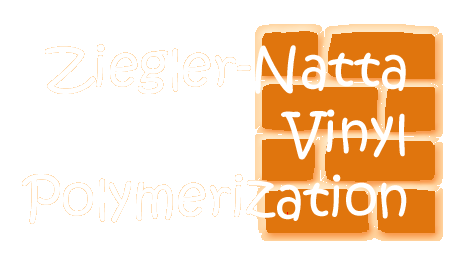Ziegler-Natta polymerization is a method of vinyl polymerization. It's important because it allows one to make polymers of specific tacticity. It was discovered by two scientists, and I think we can all figure out what their names were. Ziegler-Natta catalysis is especially useful, because it can make polymers that can't be made any other way, such as linear unbranched polyethylene and isotactic polypropylene. Free radical vinyl polymerization can only give branched polyethylene, and propylene won't polymerize at all by free radical polymerization. So this is a pretty important polymerization reaction, this Ziegler-Natta stuff.
So then how does it work? Well, it's something like this: Take your Ziegler-Natta catalyst, usually TiCl3 or TiCl4, along with an aluminum based co-catalyst, and place in the monomer at midnight on the night of the full moon. Then place the beaker on the ground in a circle of lighted candles. Now write the word "isotactic" or "syndiotactic", depending on the tacticity you desire, in runic letters on the side of the beaker with the blood of a freshly slain goat. The goat must be less than one year old, and without blemish. Then one must recite aloud the Ziegler-Natta incantation seven times, followed by the tacticity dance. If the polymerization is successful, a cold and violent wind will quickly arise and extinguish the candles, and then die away as quickly as it arose. It is important that one fast for three days before and after carrying out the ceremony. Following this little procedure usually does the trick.
Ok, so that's not really how it works, but our knowledge of how Ziegler-Natta polymerization works, and why one initiator system will work better than another, is rather limited. Picking the right conditions to make a Ziegler-Natta polymerization work often feels more like magic than science. But we do know a little bit. We know that it involves transition metal catalyst, like TiCl3. We also know that co-catalysts are involved, and these are usually based on group III metals like aluminum. Most of the time our catalyst/co-catalyst pair are TiCl3 and Al(C2H5)2Cl, or TiCl4 with Al(C2H5)3.
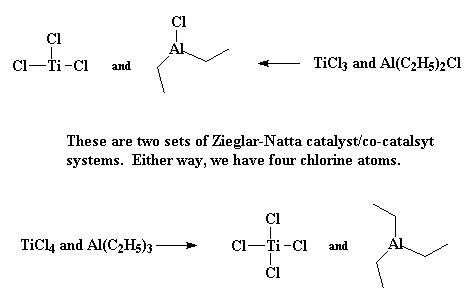
To make things simple, we'll worry about the TiCl3 and Al(C2H5)2Cl system. It helps to know something about TiCl3 to know how the system works to make polymers. TiCl3 can arrange itself into a number of crystal structures. The one that we're interested in is called α-TiCl3. It looks something like this:
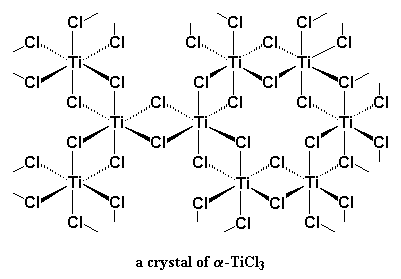
As we can see, each titanium atom is coordinated to six chlorine atoms, with octahedral geometry. That's how titanium is happiest, when it's coordinated to six other atoms. This presents a problem for the titanium atoms at the surface of the crystal. In the interior of the crystal, each titanium is surrounded by six chlorines, but on the surface, a titanium atom is surrounded on one side by five chlorine atoms, but on the other side by empty space!
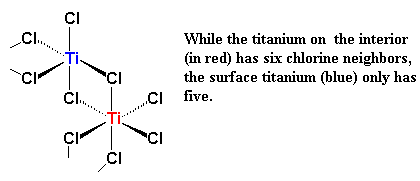
This leaves poor titanium a chlorine short. Can't it just deal with it and get on with its life? Well, no. You see, titanium is one of those transition metals, and what do we know about transition metals? We know that they have six empty orbitals (resulting from one 4s and five 3d-orbitals) in their outermost electron shells. To be happy, titanium has to be coordinated with enough atoms to put two electrons in each of the orbitals. The titanium atom on the surface of the crystal has enough neighbor atoms to fill five of the six orbital. We're left with an empty orbital, shown as an empty square in the picture below.
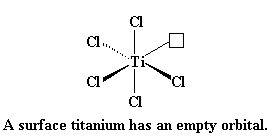
Now this state of affairs can't go on. That titanium wants to fill its orbitals. But first, Al(C2H5)2Cl enters the picture. It donates one of its ethyl groups to the impoverished titanium, but kicks out one of the chlorines in the process. We still have an empty orbital. But more about that in a moment.

As you can see in this picture, the aluminum has a hard time letting go. It stays coordinated, though not covalently bonded, to the CH2 carbon atom of the ethyl group it just donated to the titanium. Not only that, but it also coordinates itself to one of the chlorine atoms adjacent to the titanium. But titanium still has one empty orbital left to be filled.
So then a vinyl monomer like propylene comes along. There are two electrons in the π-system of a carbon-carbon double bond. Those electrons can be used to fill the empty orbital of the titanium. We say that the propylene and the titanium form a complex, and we draw it like this:
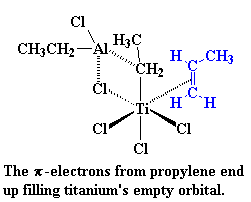
But complexation is a rather complicated process, not nearly as simple as this picture implies. Those who want the whole story can read how this complexation works, and those who want the short version, can skip straight to the polymerization:
Alkene-metal complexes
This is where it starts to get interesting. Suppose at this point that a vinyl monomer showed up, let's say, a molecule of propylene. The titanium is going to enjoy this. To understand why, let's take a look at vinyl monomer, specifically, its double bond. A carbon-carbon double bond, is made up of a σ bond and a π bond. We're going to take a closer look at that π bond.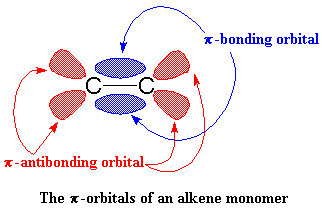
Take a look at the picture and you'll see that the π bond consists of two π-orbitals. One is the π-bonding orbital (shown in blue) and the other is the π-antibonding orbital (shown in red). The π-bonding orbital has two lobes sitting between the carbon atoms, and the π-antibonding orbital has four lobes, sticking out away from the two carbon atoms. Normally the pair of electrons stays in the π-bonding orbital. The π-antibonding orbital is too high in energy, so under normal circumstances it's empty.
Let's look again at titanium for a moment. This picture shows titanium and two of its outermost orbitals. (Yes, it has more than two, but we're only going to show two right now for clarity.)
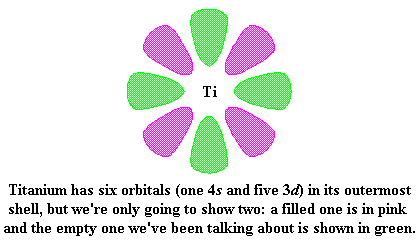
One of the titanium orbitals that we've shown is that empty orbital. It's made of the green lobes. The pink lobes are one of the filled orbitals. That empty orbital is going to look for a pair electrons, and it knows just where to look. It knows that the alkene's π-bonding orbital has a pair that it will share. So the alkene's π-bonding orbital and the titanium's d-orbital come together and share a pair of electrons.

But once they're together, that other orbital (the pink one) comes mighty close to that empty π-antibonding orbital. So the titanium orbital and the π-antibonding orbital share a pair of electrons, too.
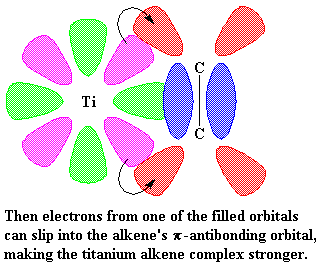
This additional sharing of electrons makes the complex stronger. This complexation between the alkene and the titanium sets things up for the next step of the polymerization.
The Polymerization
Part One: Isotactic PolymerizationThe precise nature of the complex between the titanium and the propylene is complicated. So to make things simple we're going to just draw it like we did earlier from now on, like this:
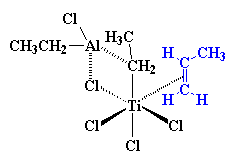
This is a nice complex, neatly solving the problem titanium had with its d orbitals not having enough electrons. But it can't go on like this. You see, that complex isn't going to stay that way forever. Some electron shuffling is going to happen. Several pairs of electrons are going to shift positions. You can see the shifting in the picture below:

We don't know exactly which pairs shifts first, but we think the first to move is that pair from the carbon-carbon p-bond that is complexed with the titanium. It's going to shift to form simple titanium-carbon bond. Then the electrons from the bond between the titanium and the carbon of the ethyl group that titanium got from Al(C2H5)2Cl. This pair of electrons is going to shift to form a bond between the ethyl group and the methyl-substituted carbon of the propylene monomer. Got that? It's kind of tricky to put into words, but we end up with the structure you see on the right side of the picture up there.
What happens next is what we call a migration. We don't know why this happens, we just know it happens. But the atoms rearrange themselves to form a slightly different structure, like this:
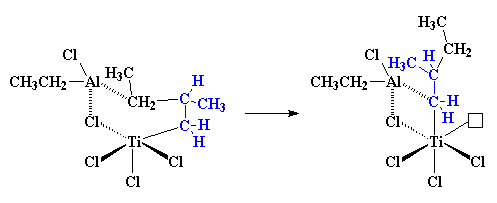
The aluminum is now complexed with one of the carbon atoms from our propylene monomer, as you can see. As you can also see, titanium is back where it started, with an empty orbital, needing electrons to fill it.
So when another propylene molecule comes along, the whole process starts all over, and the end result is something like this:
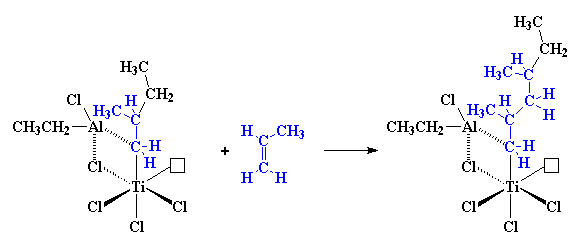
and of course, more and more propylene molecules react, and our polymer chain grows and grows. Take a look at the picture, and you'll see that all the methyl groups on the growing polymer are on the same side of the chain. With this mechanism we get isotactic polypropylene. For some reason, the incoming propylene molecule can only react if it's pointed in the right direction, the direction that gives isotactic polypropylene. We're not sure why this happens, we just know that it happens.
If you want to see a movie of isotactic Ziegler-Natta polymerization, click here!
Part Two: Syndiotactic Polymerization
The catalyst system we just looked at gives isotactic polymers. But other systems can give syndiotactic polymers. The one we're going to look at is based on vanadium rather than titanium. That system is VCl4/Al(C2H5)2Cl. It looks like the picture you see on the left, not too different from the titanium system we just looked at. But to simplify things, during this little discussion we're going to just draw what you see on the right.
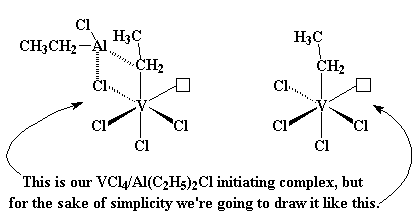
This complex will act pretty much the same way as the titanium system does when a propylene molecule comes its way. First the propylene complexes with the vanadium, then the electrons shift just like before, and the propylene is inserted between the metal and the ethyl group, just like before. This is all shown in the picture below.

But you can also see an important difference in this picture. Remember how with the titanium system, the growing polymer chain shifts positions on the titanium atom? You'll notice that doesn't happen here. The growing polymer chain stays in its new position. That is, until another propylene molecule comes along. This second propylene reacts while the growing chain is still in its new position, just like you see below:
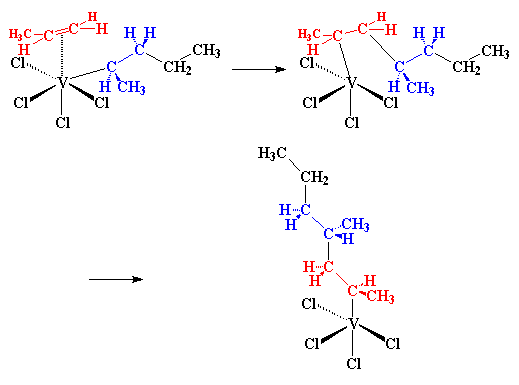
But notice that when the second propylene adds to the chain, the chain changes position again. It's back in the position where it started. Take a look at the methyl groups of the first monomer, in blue, and the second monomer, in red. Notice that they're on opposite sides of the polymer chain. When the growing polymer chain is in one position the propylene monomer can only add so that the methyl group is on one side of the chain. When the chain is in the other position, propylene can only add so that the methyl group hangs off the other side. We're not exactly sure why this is. But we do know that because the growing polymer chain switches positions with each propylene monomer added, the methyl groups end up on alternating sides of the chain, giving us a syndiotactic polymer.
If you'd like to see a movie of how syndiotactic Ziegler-Natta polymerization takes place, click here!
Limitations
Ziegler-Natta polymerization is a great way to make polymers from hydrocarbon monomers like ethylene and propylene. But it doesn't work of for some other kinds of monomers. For example, we can't make poly(vinyl chloride) by Ziegler-Natta polymerization. When the catalyst and cocatalyst come together to form the initiating complex, radicals are produced during intermediate steps of the reaction. These can initiate free radical polymerization of the vinyl chloride monomer. Acrylates are out, too, because Ziegler-Natta catalysts often initiate anionic vinyl polymerization in those monomers.
Moving Forward
For a long time, Ziegler-Natta polymerization was the most useful and versatile reaction for producing polymers of a specific desired tacticity. But recently a new type of polymerization, also using metal complexes as initiators, has been developed, called metallocene catalysis polymerization. It's hot, so go read about it!

|
Return to Level Four Directory |

|
Return to Macrogalleria Directory |
